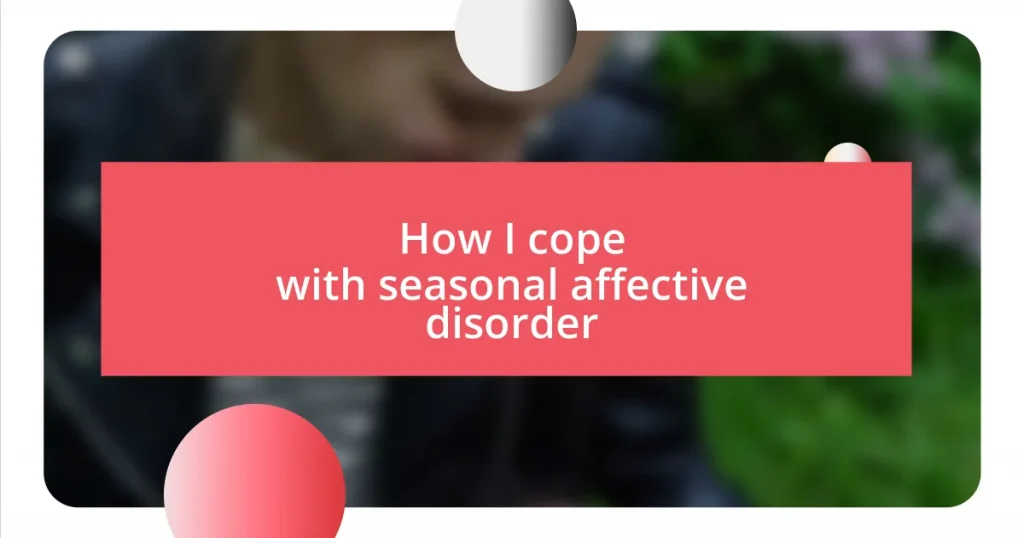Key takeaways:
- Seasonal Affective Disorder (SAD) is a severe form of depression caused by reduced sunlight exposure, leading to symptoms like low mood, fatigue, and social withdrawal.
- Light therapy significantly helps improve mood and energy levels, making it an effective strategy for managing SAD alongside lifestyle changes such as maintaining routine, exercising, and proper nutrition.
- Connecting with social support, practicing mindfulness, and incorporating gratitude into daily life can alleviate feelings of isolation and enhance overall well-being during the winter months.
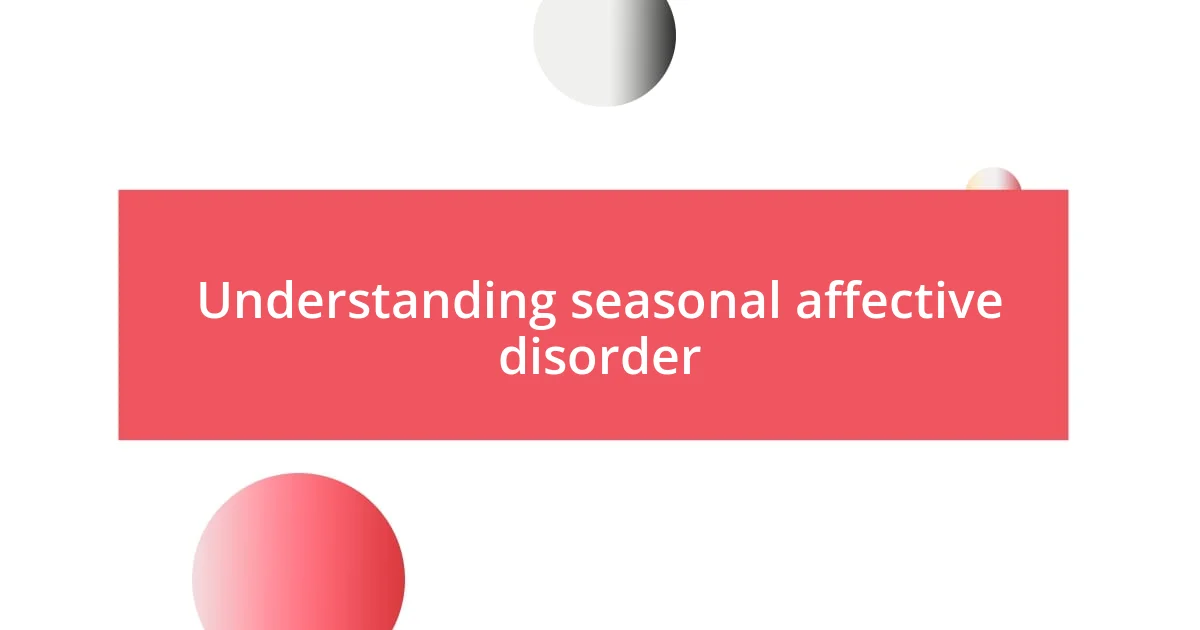
Understanding seasonal affective disorder
I often find myself questioning why the colder months bring such a heavy cloud over my mood. Seasonal Affective Disorder (SAD) is more than just the winter blues; it’s a severe form of depression that typically strikes during the fall and winter. This condition stems from changes in light exposure, particularly the reduced sunlight that can disrupt our circadian rhythms and lead to feelings of lethargy and hopelessness.
When I first learned about SAD, it felt like a lightbulb moment. I realized my struggles weren’t due to personal weakness but were instead a biological response to the seasons. Understanding that the brain’s serotonin and melatonin levels play a crucial role in regulating mood helped me make sense of those particularly gloomy winter days.
Have you ever felt an inexplicable sadness as the days get shorter? That gut-wrenching sense of isolation can be overwhelming. The emotional weight that comes with SAD can be hard to articulate, yet acknowledging its existence makes it a little easier to navigate. Grappling with these feelings has taught me the beauty of seeking light—not only in the literal sense but also in finding joy in small daily moments.
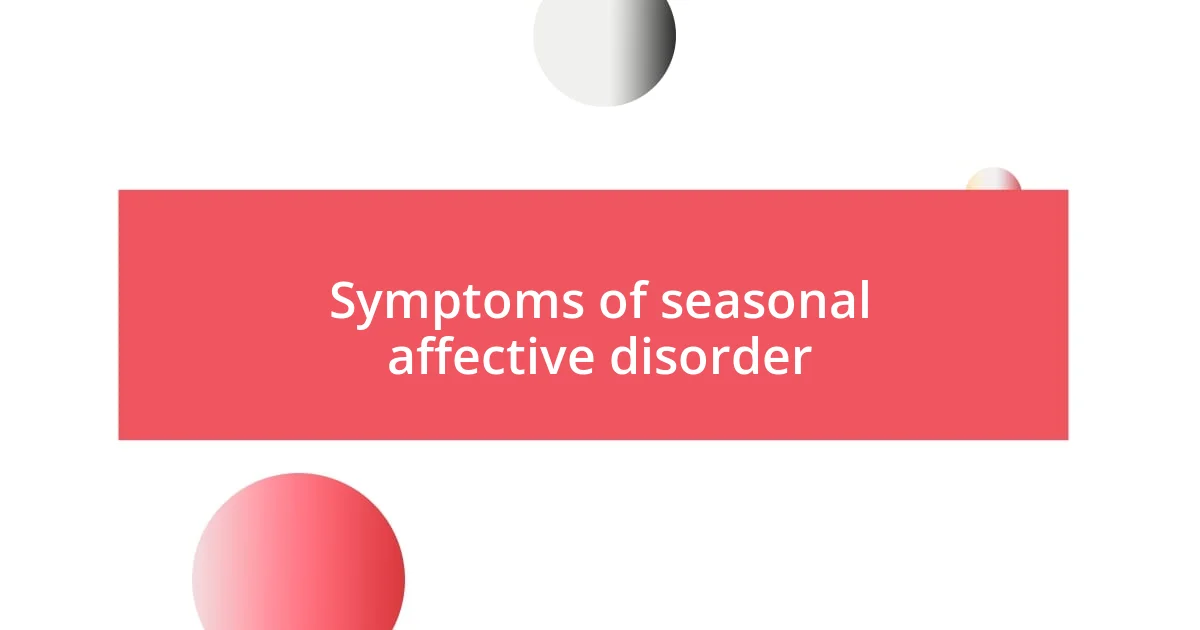
Symptoms of seasonal affective disorder
The symptoms of Seasonal Affective Disorder can feel all-consuming. One of the most common indicators is a pervasive low mood that seems to seep into every aspect of daily life. Personally, I’ve experienced days where even simple tasks, like getting out of bed or having breakfast, felt like climbing a mountain. It’s surprising how such a shift in light can create such a drastic change in mood and energy levels.
In addition to sadness, many people with SAD often struggle with fatigue and a lack of motivation. I remember a winter when I would scroll through social media, seeing friends outdoors, enjoying life while I felt tethered to the couch. It’s not just the mental weight; physical symptoms can accompany that sense of gloom, including disrupted sleep patterns and changes in appetite. For instance, I craved carbs more than usual, perhaps as a way to comfort myself during those chilly, dim days.
Interestingly, some individuals may also experience an increase in social withdrawal—something I definitely went through. I became hesitant to engage with friends and family, finding solace in solitude rather than connection. Reflecting on these symptoms helped me recognize the cyclical nature of SAD and the importance of being aware of these signs within myself.
| Symptom | Description |
|---|---|
| Low Mood | Persistent feelings of sadness and hopelessness. |
| Fatigue | Increased exhaustion and lack of motivation. |
| Social Withdrawal | A tendency to isolate oneself from friends and family. |
| Changes in Sleep | Difficulties with sleep patterns, either insomnia or oversleeping. |
| Appetite Changes | Cravings for comfort foods, especially carbohydrates. |
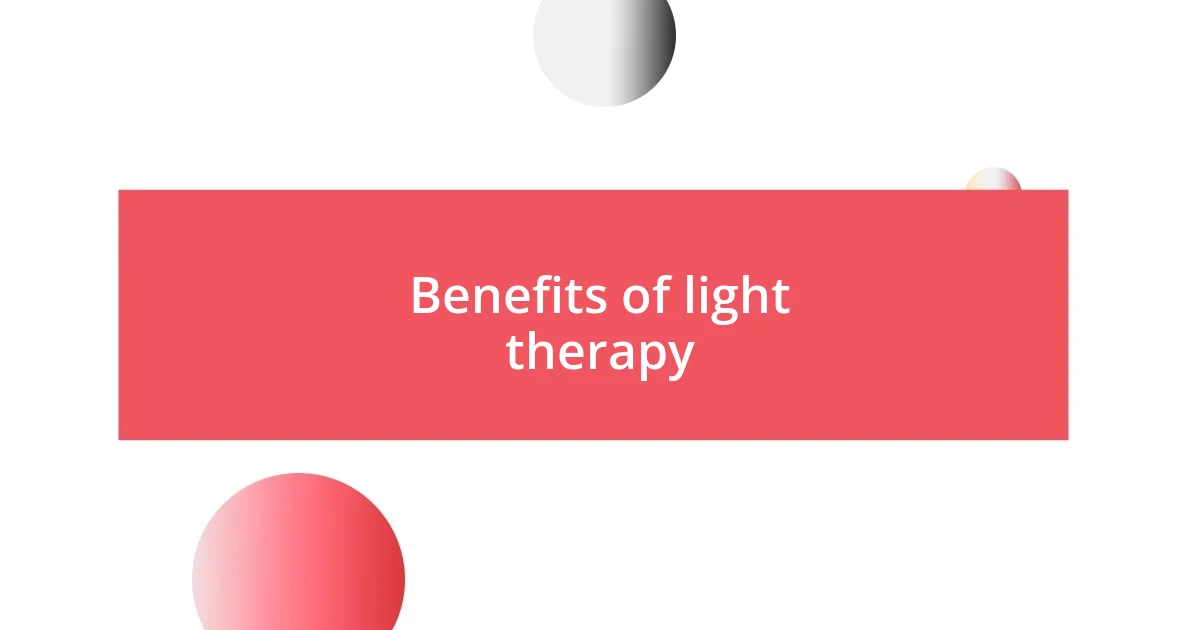
Benefits of light therapy
Bright light therapy has been a game changer for me in managing the shadows of SAD. The exposure to artificial light mimics the sunlight we desperately miss in winter, making a noticeable difference in my mood and energy levels. I remember the first time I tried it; it felt like flicking a switch that illuminated not just the room but also my spirit.
Here are some benefits of light therapy that I’ve come to appreciate:
- Improved Mood: Increased light exposure helps boost serotonin levels, naturally lifting that heavy fog of sadness.
- Enhanced Energy: I often find that using a light box in the morning sparks a burst of energy that lasts throughout the day.
- Better Sleep: Regular exposure to bright light helps regulate my sleep-wake cycle, leading to a more restful night’s sleep.
- Reduced Fatigue: Personally, I’ve noticed less of that pervasive tiredness that often plagues me during darker months.
- Increased Motivation: On days when I integrate light therapy, I’m more inclined to tackle my to-do list rather than scroll aimlessly through my phone.
Incorporating light therapy into my routine has been enlightening, quite literally. It serves as my morning ritual—sipping coffee while basking in that bright glow reminds me that even in the midst of winter, there’s a way to bring light into my life. If you’ve been feeling stuck in the clutches of SAD, this might just be the spark you need.
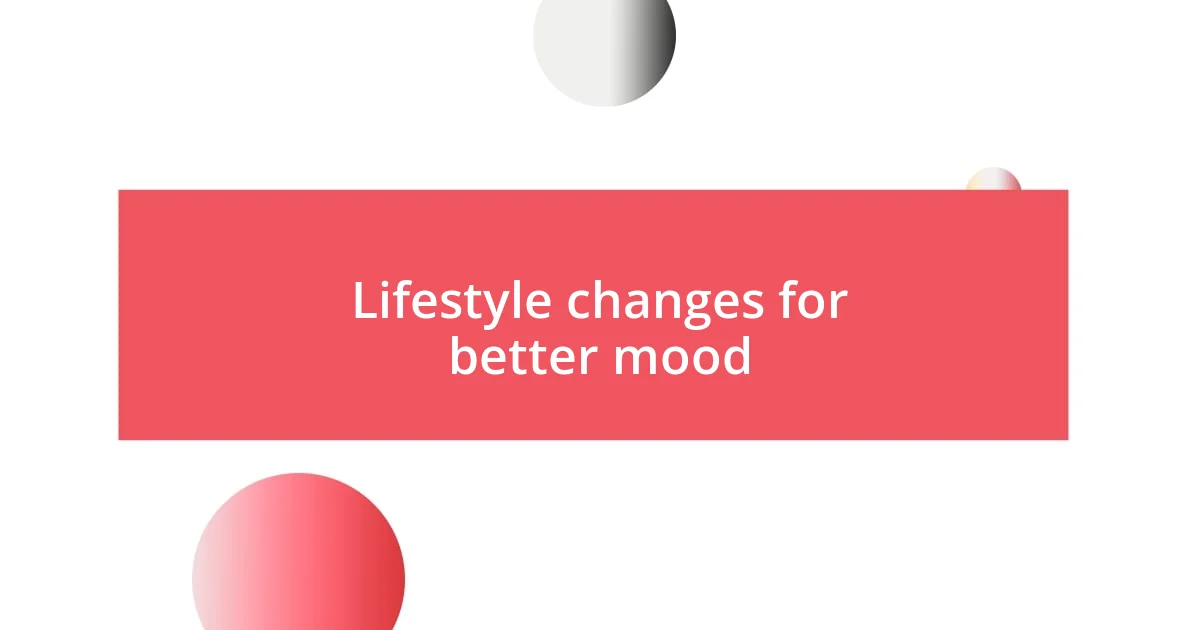
Lifestyle changes for better mood
Adjusting certain lifestyle habits has truly transformed my experience with seasonal affective disorder. For example, I’ve found that establishing a consistent daily routine brings a sense of stability amidst the chaos of changing seasons. Have you ever noticed how a little predictability can anchor your mood? I started going to bed and waking up at the same time every day, and it’s helped improve my overall sense of well-being.
Another change that made a significant difference was integrating physical activity into my life. Initially, it felt like an uphill battle, especially when the couch seemed all too inviting during gloomy days. However, I pushed myself to step outside, even for a short walk, and the fresh air worked wonders. I vividly remember one delightfully sunny afternoon—despite the chill, that walk sparked a wave of gratitude for the little things, like the crispness of the air and the sound of rustling leaves.
Lastly, I’ve realized the importance of nutrition in boosting my mood. For a long time, I leaned on comfort foods, seeking solace in heavy carbs. However, I started experimenting with meals rich in Omega-3 fatty acids, such as salmon and walnuts, and that shift has been enlightening. It’s fascinating how what we eat can affect our mental health—have you ever considered how your diet might be influencing your mood? Understanding that connection has not just improved my physical health but also lightened the clouds of winter sadness hovering over me.

Nutrition tips to combat SAD
I’ve discovered that the right nutrition can play a significant role in managing seasonal affective disorder. When winter sets in, I used to crave sugary snacks, thinking they’d bring a quick mood boost. But I’ve found that instead of helping, they often left me feeling more sluggish. Now, I focus on incorporating whole foods, like spinach and quinoa, into my meals. It’s surprising how meals rich in nutrients can shift my outlook. Have you ever noticed how a colorful plate can brighten your day?
One of the game-changing shifts I made was adding probiotics to my diet. I was skeptical at first—could a yogurt really make a difference? Yet, I’ve found that foods like kefir and sauerkraut not only support my gut health but also seem to elevate my mood during the darker months. It’s all connected, isn’t it? Our mental well-being often mirrors how we care for our bodies. I remember a week when I diligently included probiotics, and the clarity I felt was remarkable; I was energized and less weighed down by the seasonal gloom.
Lastly, hydration plays a more vital role than I ever imagined. In winter, I often forget to drink enough water, but I’ve learned that staying hydrated keeps my energy levels stable. I started filling up a large water bottle in the morning, and it’s fascinating how often I reach for it throughout the day. Have you ever tried infusing your water with fruits like lemon or berries? The refreshing taste not only encourages me to drink more but also adds a vibrant flair to my routine. I noticed that when I’m well-hydrated, my mood tends to reflect that small victory, making it easier to face the day with hope rather than heaviness.
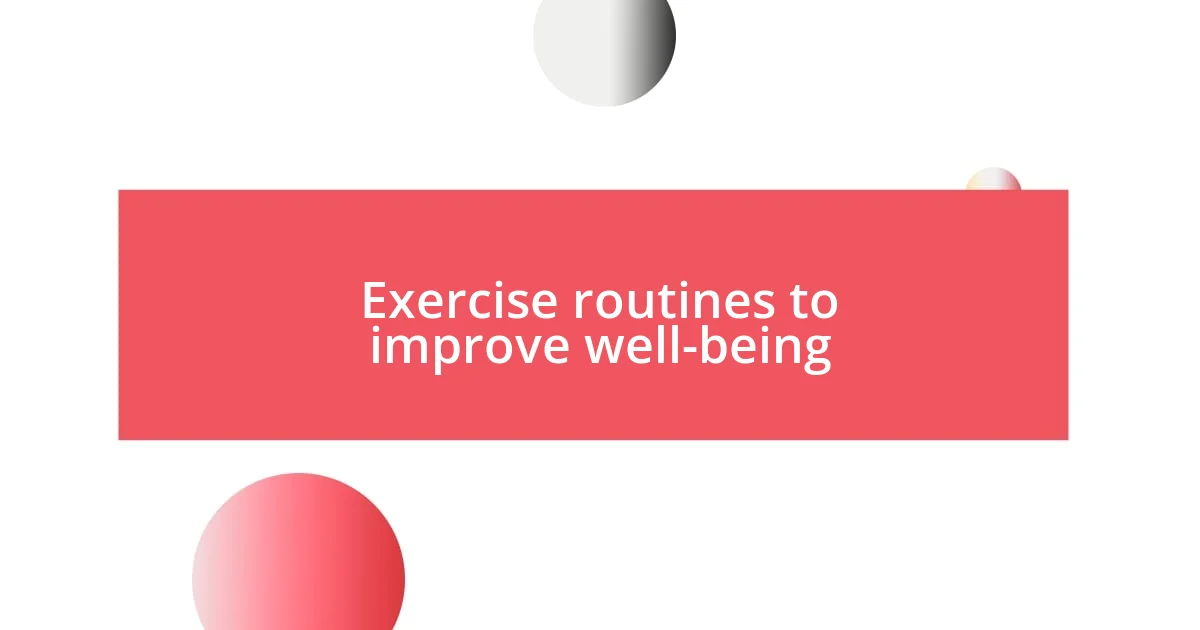
Exercise routines to improve well-being
Incorporating exercise into my routine has been a game changer for my well-being. I’ve found that even a brisk 20-minute walk can do wonders for my mood. There was a day when I felt particularly down, and with just a little push, I stepped outside for a jog. The endorphins kicked in, and suddenly, the weight of winter felt lighter. Have you ever experienced that rush after moving your body? It’s like a natural reset button.
One of my go-to routines has become a mix of strength training and yoga. Initially, I turned to weights thinking they would only build physical strength. However, I quickly realized that the focus required during those sessions helped clear my mind and sharpen my outlook. There’s a moment of peace, usually at the end of my yoga practice, when I find myself lying in Savasana, feeling completely relaxed. It’s almost meditative. Do you have a favorite way to unwind through movement? I encourage you to explore different activities until you find one that resonates.
I also became a big fan of group classes. While I used to dread the idea of showing up in a room full of strangers, I’ve since discovered that the shared experience of working out can be incredibly uplifting. I remember my first Zumba class, where the energy was contagious, and I couldn’t help but smile while dancing away the winter blues. That sense of community, forged through collective effort, often extends beyond the class itself, sparking connections that brighten my days. Have you felt that sense of belonging in a workout setting? It’s something truly special.
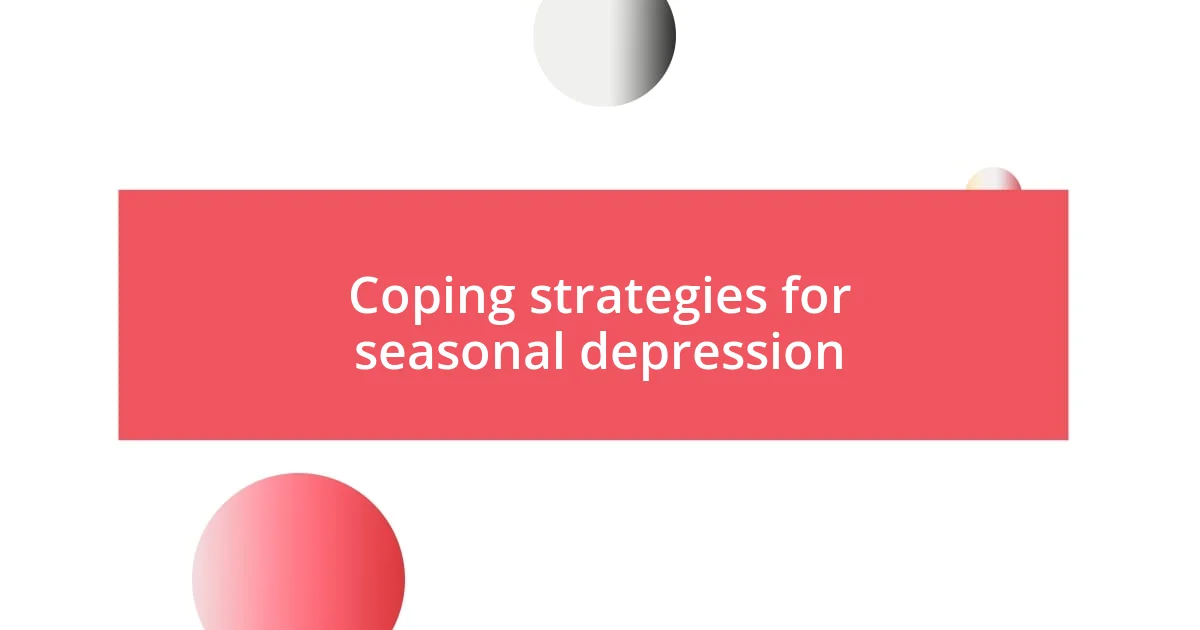
Coping strategies for seasonal depression

Coping strategies for seasonal depression
One of the most impactful strategies I’ve embraced is light therapy. In those dreary winter months, I invested in a light therapy box, and the results have been astonishing. I remember one particularly gray morning when I sat in front of the light for 30 minutes while sipping my coffee. It’s like flipping a switch—suddenly, I felt a warmth spreading both physically and emotionally. Have you experienced that moment when the sun peeks out after days of clouds? That’s how these sessions feel.
Another powerful strategy is maintaining my social connections. When winter settles in, I tend to retreat, but making an effort to connect with friends has been a lifesaver. I recall a time when I felt isolated and decided to invite a few friends over for a cozy movie night. Sharing laughter and stories, it felt as if the weight of the season lifted just a little. Isn’t it fascinating how simply being around others can ignite a spark of joy amidst the cold? I consistently try to schedule these moments; they remind me that I’m not alone in this.
Practicing mindfulness and gratitude has also transformed my daily experience. I set aside a few minutes each day to write down things I’m grateful for. It’s particularly powerful on days when I feel a bit heavy-hearted. I recall jotting down simple moments, like the warmth of my favorite blanket or the comfort of a good book. These reflections serve as gentle reminders that even in the depths of winter, there’s still light to be found. How about you? Have you ever tried harnessing gratitude to shift your perspective? It’s a small practice that can lead to significant shifts in mood.










